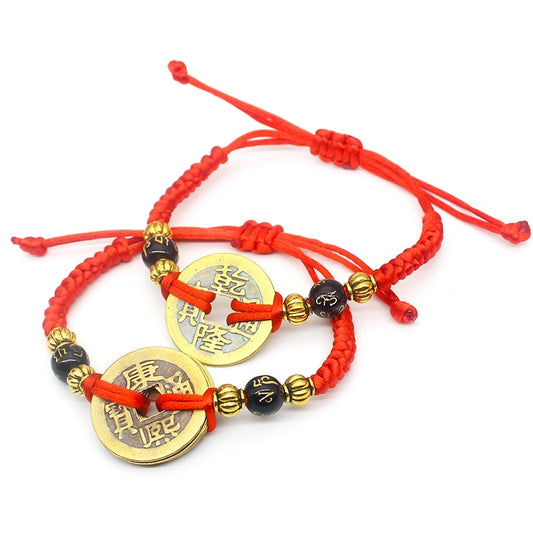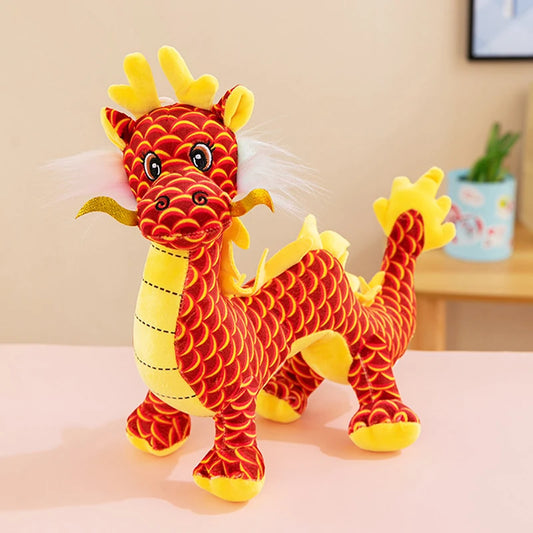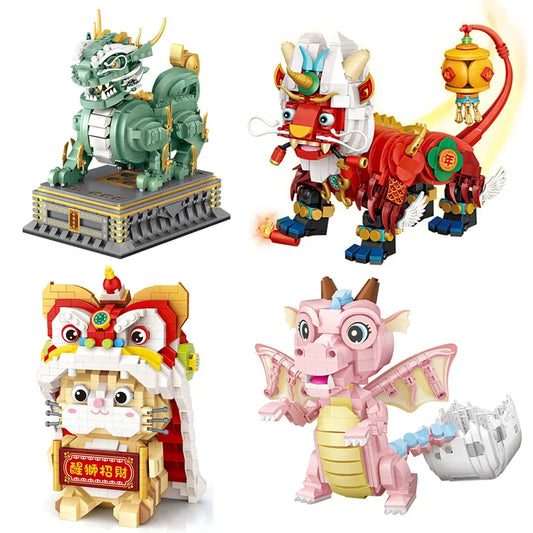China, with its rich history and diverse culture, boasts a treasure trove of mythical creatures that have captured the imagination of people for centuries. These enchanting beings have found their way into folklore, literature, and art, weaving themselves into the tapestry of Chinese heritage. In this article, we embark on a mystical journey to discover the top ten Chinese mythical creatures, each with its own unique charm and significance.
The Celestial Dragon: Guardian of the Cosmos
A Divine and Majestic Being
Among the most revered and iconic of Chinese mythical creatures is the Celestial Dragon. These majestic beings are often seen as benevolent forces, ruling over the heavens and the cosmos. Unlike the Western image of dragons as destructive and malevolent, Chinese dragons are symbols of power, strength, and good fortune.
In Chinese mythology, dragons are associated with water, particularly rivers and seas, and are believed to have the power to control rain and protect against droughts. They are also guardians of ancient treasures, and it is said that the Dragon Gate, a waterfall in China, is the place where a carp can transform into a dragon after swimming upstream.

Cultural Significance
The dragon holds immense cultural significance in China. It is a symbol of imperial power and has been used extensively in the country's history, appearing on everything from flags to the robes of emperors. The famous Imperial Dragon Robe, adorned with intricate dragon motifs, is a testament to the dragon's symbolic importance in Chinese culture.
The dragon dance, a traditional Chinese performance during festivals and celebrations, is another illustration of the dragon's cultural prominence. It involves a group of performers manipulating a long, colorful dragon puppet in intricate choreography, symbolizing the dragon's benevolence and power.
The Phoenix: Symbol of Rebirth and Renewal
An Iconic Bird of Myth and Legend
The Phoenix, known as Fenghuang in Chinese, is a mythical bird associated with renewal, rebirth, and immortality. Unlike the fire-breathing Western dragon, the Phoenix is a gentle and elegant creature, often depicted as a magnificent bird with radiant plumage.
In Chinese mythology, the Phoenix is often paired with the dragon, representing the balance of yin and yang. The dragon symbolizes the masculine and the Phoenix the feminine, creating a harmonious union of opposites. This pairing signifies the perfect balance of forces in the universe.

Immortality and Symbolism
The Phoenix is closely associated with the concept of immortality. Legends tell of the bird's ability to consume itself in flames and then be reborn from its ashes, symbolizing the cyclical nature of life and death. This theme of renewal has made the Phoenix an enduring symbol in Chinese culture, often used to represent new beginnings and opportunities.
In Chinese art and literature, the image of the Phoenix frequently appears, especially in works about love and marriage. The pairing of a dragon and a Phoenix is considered the ultimate symbol of marital bliss, symbolizing the harmony between husband and wife.
The White Tiger: Guardian of the West
A Fierce and Powerful Protector
In Chinese mythology, the White Tiger, or Bai Hu, is one of the Four Symbols representing the cardinal directions. It is associated with the west and is often depicted as a formidable and majestic creature, resembling a large white tiger.
The White Tiger is considered a guardian and protector, responsible for maintaining balance and warding off evil spirits. It is believed to possess the power to control the wind and has the ability to summon rain, making it an essential deity for agricultural societies.

Symbol of Strength and Authority
Throughout Chinese history, the White Tiger has been associated with strength and authority. It is often depicted alongside the Vermilion Bird (representing the south), the Azure Dragon (representing the east), and the Black Tortoise (representing the north) as part of the Four Symbols.
In ancient times, the White Tiger was believed to be a symbol of the ruling dynasty's authority and power. Emperors and warriors would adorn themselves with White Tiger symbols to invoke protection and strength in battle.
The Nian: A Fearsome Beast Tamed by Tradition
A Creature of Folklore
The Nian is a mythical creature that originates from Chinese folklore and is known for its terrifying appearance. According to legend, the Nian would come out of hiding on the eve of the Chinese New Year to terrorize villages, devouring livestock and even villagers.
The Nian is typically described as a lion-like creature with a long, sharp horn on its head. It is said to be highly sensitive to loud noises and the color red, which led to the development of various customs and traditions aimed at warding off the creature.

Customs and Traditions
To protect themselves from the Nian's attacks, people developed a range of customs that are still practiced today during the Chinese New Year. These customs include lighting firecrackers to scare away the Nian with loud noises, hanging red lanterns and scrolls to symbolize good luck, and wearing red clothing to ward off evil.
Over time, the Nian has evolved from a feared monster into a symbol of the triumph of tradition and community over adversity. The customs associated with the Nian continue to be an integral part of Chinese New Year celebrations, emphasizing the importance of unity and shared cultural heritage.
The Monkey King: A Mischievous Hero
A Legendary Figure
The Monkey King, also known as Sun Wukong, is a legendary character from the Chinese classical novel "Journey to the West." This mythical creature is not your typical hero; he is mischievous, rebellious, and endowed with extraordinary powers.
Sun Wukong is a monkey who gains immortality and incredible strength through Taoist practices. He wreaks havoc in heaven, defeats formidable foes, and embarks on a journey to obtain sacred Buddhist scriptures. Along the way, he acquires a magical staff and a host of loyal companions.

A Symbol of Perseverance and Resourcefulness
The Monkey King embodies qualities such as perseverance, resourcefulness, and a sense of justice. Despite his initial mischief, he ultimately becomes a heroic figure who uses his powers for noble purposes. His adventures in "Journey to the West" serve as a moral tale, emphasizing the importance of self-improvement and transformation.
The Monkey King's popularity extends beyond literature; he is a beloved character in Chinese culture, frequently depicted in various forms of media, including film, television, and theater. His story continues to inspire and captivate audiences worldwide.
The Huli Jing: Enchanting Fox Spirits
Cunning and Seductive
The Huli Jing, or Fox Spirit, is a fascinating creature in Chinese mythology. These supernatural beings are often portrayed as beautiful women who can transform into foxes. They possess intelligence, cunning, and the ability to seduce humans, sometimes leading to tragic consequences.
Huli Jing are believed to have the power to shape-shift, often assuming the form of a beautiful woman to lure unsuspecting victims. While some stories depict them as malevolent, others portray them as more benevolent beings, capable of love and compassion.

Cultural Significance
The concept of the Huli Jing has had a significant influence on Chinese literature and culture. They appear in classical Chinese texts, including poetry and novels, where they are often used as metaphors for human desires and the allure of the unknown. The Huli Jing's dual nature, embodying both good and evil, reflects the complexity of human nature itself.
In contemporary Chinese culture, the Huli Jing continues to be a popular subject in literature, film, and television, exploring themes of identity, temptation, and transformation. The enduring appeal of these enchanting fox spirits lies in their ability to reflect the timeless and universal aspects of the human experience.
The Jiangshi: The Hopping Vampire
A Unique and Eerie Creature
The Jiangshi, often referred to as the "hopping vampire" or "reanimated corpse," is a creature of Chinese folklore that has captured the imaginations of many. Unlike traditional vampires, Jiangshi do not suck blood; instead, they feed on the life force or "qi" of the living.
Jiangshi are reanimated corpses, often the result of improper burial rites or unfinished business in the afterlife. They are known for their stiff, jerky movements, which give rise to their distinctive hopping gait. These creatures are typically depicted with long white hair, dressed in Qing Dynasty clothing.

Influence on Pop Culture
The Jiangshi has left a significant mark on popular culture, particularly in Chinese and Hong Kong cinema. It has appeared in numerous horror films and television series, both in its traditional form and as a subject of comedic reinterpretations.
The Jiangshi's unique blend of horror and humor has made it a beloved and enduring figure in the horror genre. Its influence has even spread beyond Chinese-speaking regions, as international audiences have embraced its eerie and comical presence.
The Bai Ze: A Mysterious Seer
An Unusual Mythical Creature
The Bai Ze is a lesser-known mythical creature in Chinese folklore but is no less intriguing. Described as a white, tiger-like beast with one or multiple eyes on its forehead, the Bai Ze is said to have the ability to speak and possesses knowledge of supernatural and spiritual matters.
According to legend, the Bai Ze appeared to Emperor Huangdi and imparted knowledge about various supernatural creatures, their characteristics, and their abilities. This information served as a valuable guide for the emperor in dealing with these entities.

A Source of Folk Wisdom
While the Bai Ze may not be as widely recognized as other mythical creatures, its role in Chinese folklore highlights the importance of knowledge and wisdom in dealing with the unknown. The creature's ability to provide insights into the supernatural world underscores the belief in the coexistence of both the earthly and spiritual realms in traditional Chinese culture.
The Bai Ze serves as a reminder of the rich tapestry of myths and legends that have shaped Chinese culture and history, demonstrating the value of embracing and preserving such folklore for future generations.
The Gui Po: Vengeful Female Ghosts
Ghosts with Unfinished Business
The Gui Po, or "vengeful female ghost," is a haunting figure in Chinese folklore. These spirits are typically women who have suffered a traumatic or unjust death and are consumed by a desire for revenge or justice.
Gui Po are often depicted as pale, disheveled women dressed in white burial garments. They are known for their eerie appearance and their propensity to appear at night, seeking retribution against those they hold responsible for their suffering.
Tales of Tragedy and Redemption
Gui Po stories often center on themes of tragedy and redemption. While these spirits are driven by a desire for vengeance, they are also portrayed as tragic figures who have been wronged in life. Some tales explore the possibility of redemption for Gui Po, highlighting the complexity of human emotions and the potential for forgiveness.
These ghostly legends serve as cautionary tales, reminding individuals of the consequences of their actions and the importance of seeking justice and reconciliation in both life and death.
The Xing Tian: A Headless Warrior
A Tenacious and Unyielding Warrior
Xing Tian is a mythical character known for his tenacity and unwavering determination. In Chinese mythology, he was a warrior who fought against the supreme deity, the Jade Emperor, in a battle of great significance. Despite losing the battle and his head, Xing Tian continued to fight with his nipples as his eyes and his navel as his mouth.
Xing Tian's refusal to give up, even in the face of defeat and decapitation, is a symbol of indomitable spirit and resilience. His story has inspired countless tales of determination and perseverance in the face of adversity.
A Symbol of Unconquered Willpower
Xing Tian's legend serves as a testament to the enduring human spirit and the belief that one should never surrender to despair or adversity. His story has been embraced in various forms of media, literature, and art as a symbol of unyielding willpower and the refusal to accept defeat.
In modern times, Xing Tian's tale continues to resonate with individuals facing challenges and obstacles, offering a message of hope and the power of resilience to overcome even the most daunting adversities.
Conclusion
The world of Chinese mythical creatures is a captivating realm filled with a diverse array of beings, each with its own unique qualities, symbolism, and cultural significance. From the majestic Celestial Dragon to the mischievous Monkey King, these mythical creatures have enriched Chinese culture and storytelling for centuries.
As we delve into the stories and legends of these creatures, we gain a deeper appreciation for the rich tapestry of Chinese mythology and the enduring themes of balance, transformation, and resilience that they represent. Whether they serve as protectors, cautionary figures, or sources of wisdom, Chinese mythical creatures continue to inspire and intrigue, reminding us of the power of storytelling to shape culture and identity.









